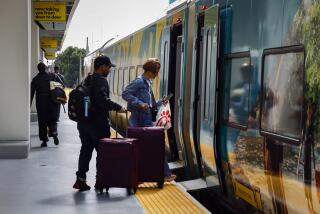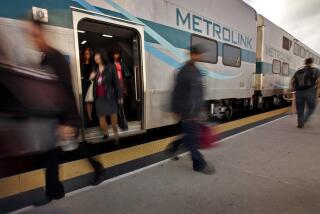‘Maglev’ Research Puts Hope of High-Speed Trains on Fast Track
- Share via
Science-fiction buffs know the scene well: A high-speed train zips silently across the country without even touching the tracks, suspended in midair by an exotic technology known as magnetic levitation.
For years, scientists and engineers have tried to turn that dream into a working machine, but aside from test trains in Germany and Japan, you can’t climb aboard a “maglev” train anywhere in the world.
But now, a small team of scientists and engineers at the Lawrence Livermore National Laboratory has developed a system that could give new life to the world of magnetic levitation.
They built a working model in the basement of their lab to demonstrate the principle, said physicist Richard F. Post, who heads the team. It works, and Post thinks it might be useful for everything from commuter trains to launching rockets. So, apparently, does the National Aeronautics and Space Administration.
There are several ways of achieving magnetic levitation, but they all involve the same physics.
For a train, electromagnets are attached to the underside of the cars, and other electromagnets are embedded in the tracks. The two layers of magnets repel each other, thus lifting the entire train a fraction of an inch above the rails. That reduces noise and friction because no wheels roll along the tracks, and it should make it possible to achieve speeds well in excess of 200 mph.
But the powerful magnets used in “maglev” experimental trains require superconducting coils that have to be supercooled, and complex control systems to keep the trains stable and safe. In short, they are just too complicated.
The Livermore team has explored an entirely different technique that is astonishing in its simplicity.
Instead of all those energy-hogging superconducting electromagnets favored in Japan and Germany, the Livermore team decided to use permanent magnets--the sort of things used to attach recipes to the refrigerator door. But a lot bigger.
Others had thought of it before, Post said, “but they couldn’t get the kind of forces compared to the weight of the magnets that one needs.”
So the Livermore team added a new wrinkle by borrowing from the world of high-energy physics. A number of years ago, Klaus Halbach, then a physicist at the Lawrence Berkeley Lab, came up with a better way to keep charged particles confined to a fine beam as they travel inside a particle accelerator.
He arranged permanent magnets around the accelerator in a configuration called the Halbach array.
The array “creates a very strong magnetic field on the lower surface of the array and almost totally cancels it on the upper surface,” Post said. In effect, that allows the power of the magnet to be concentrated in one direction, “so you are getting the maximum utilization of the magnetic material.”
In the lab’s test train, dubbed Inductrack, the permanent magnets were attached to the underside of the train. As the train moved down the track, the magnets passed over passive coils of insulated copper wire embedded in the tracks, inducing a current in the coils, which in turn produced a magnetic field.
The two magnetic fields repelled each other, lifting the train off the tracks.
“It’s actually quite simple,” Post said.
The model, constructed by project engineer J. Ray Smith and technician Bill Kent, has wheels that roll along the track until it reaches about 1 mph. That’s enough to generate the magnetic levitation to lift the entire train.
A full-scale system would operate much the same way, using wheels as it enters and leaves the station, for example, and then lifting up and zipping away. If for any reason the system should fail, the train would settle back on its wheels and come to a stop.
Part of the beauty of the system, Post said, is that it lends itself to various types of propulsion. A turbine could be used for high-speed, cross-country runs, for example, and an electric drive for intercity commutes.
And because the magnetic field is canceled out above the magnets, there is no need to shield passengers to protect such things as heart pacemakers.
Tests at Livermore show that the magnets should lift nearly 50 times their own weight, and an array 1 square yard in size should lift up to 25 tons, so the magnets themselves are only a small percentage of the weight of the train.
According to a feasibility study by Booz, Allen & Hamilton, Inductrack system trains should reach speeds of more than 200 mph with lower energy costs, less maintenance and noise, and less wear on wheels and rails than on conventional rail systems. It would, however, be more expensive to build. But it would still cost less than other maglev technologies, according to the study.
The Livermore project caught the eye of NASA, which has long dreamed of using maglev technology to launch rockets.
“We’re in the second year of a three-year contract with NASA” to build a demonstration project, Post said.
Chemical rockets are not very fuel-efficient at ground level, and NASA would like to use such a system as the first stage in launching large rockets. Post said their prototype will use a track that slopes upward. The system will be far more complex than the model train’s, allowing the rocket to achieve gravitational forces of 10 Gs as it speeds up the track.
Post hopes to have it traveling at at least half the speed of sound by the time it reaches the end, when the rocket’s main engine would take over.
“This would save them something like 30% to 40% of their fuel and allow them to reach orbit with a single-stage rocket,” he said.
That would be more impressive than a model in the basement of the Livermore lab, but even that may not be convincing enough for planners of mass-transit systems.
Mehdi Morshed, executive director of the California High Speed Rail Authority, said his organization has looked at maglev prototypes in Germany and Japan. They are impressive, he said, but would they--or any sort of maglev system--withstand the rigors of commuter life?
“The technology is great,” he said, “but we don’t have any place where anybody has any experience with a maglev system in revenue service.”
Before anyone commits billions of dollars to a multiyear program, Morshed said, it would be nice to see one that works. “If you build a steel-wheel train,” he said, “at least you can go look at something someone else has built.”
*
Lee Dye can be reached at [email protected].






